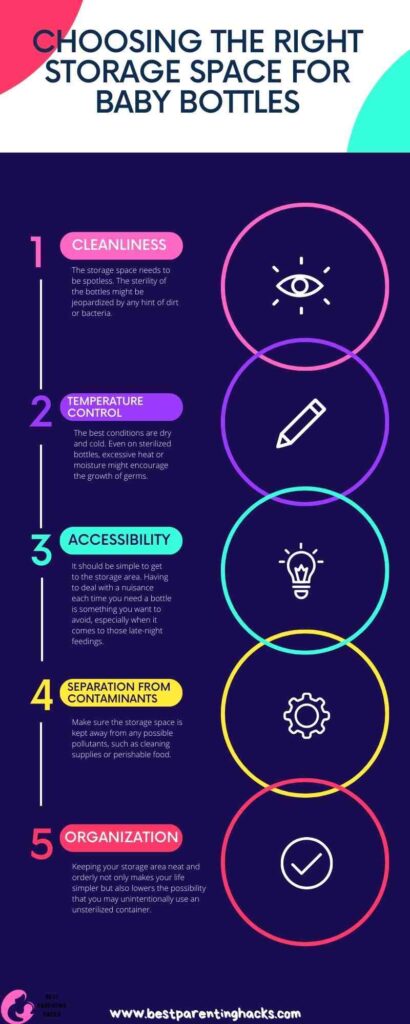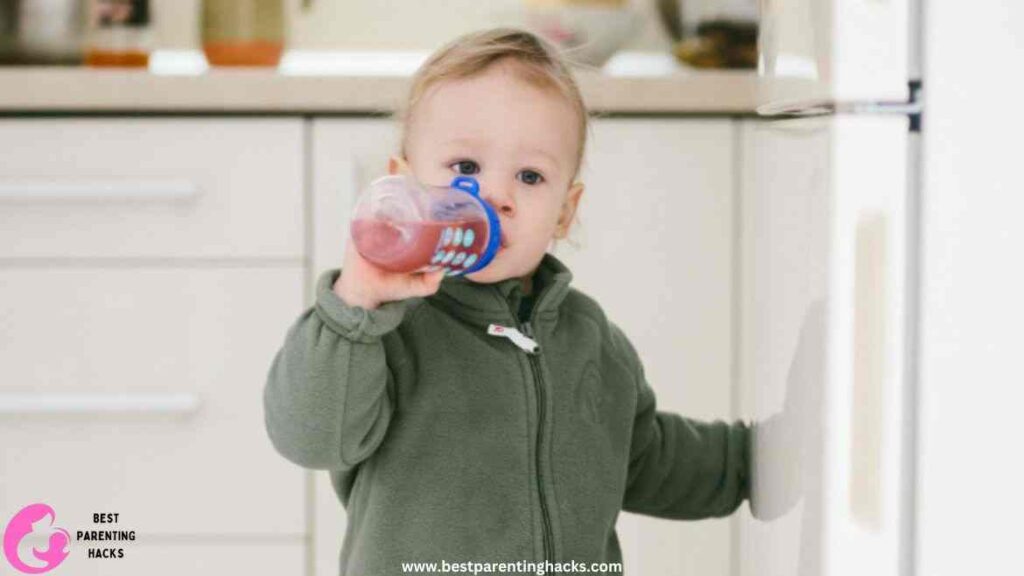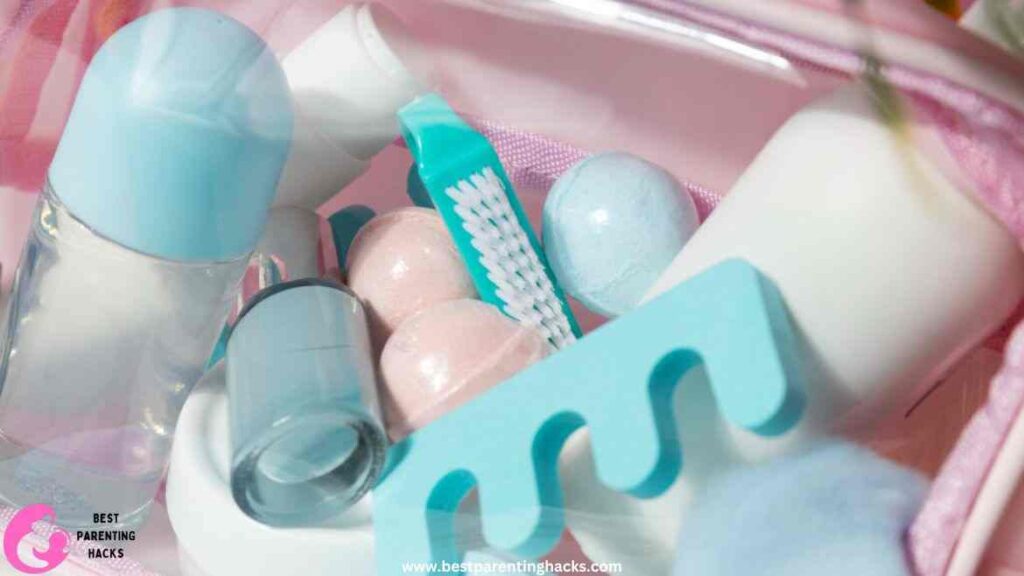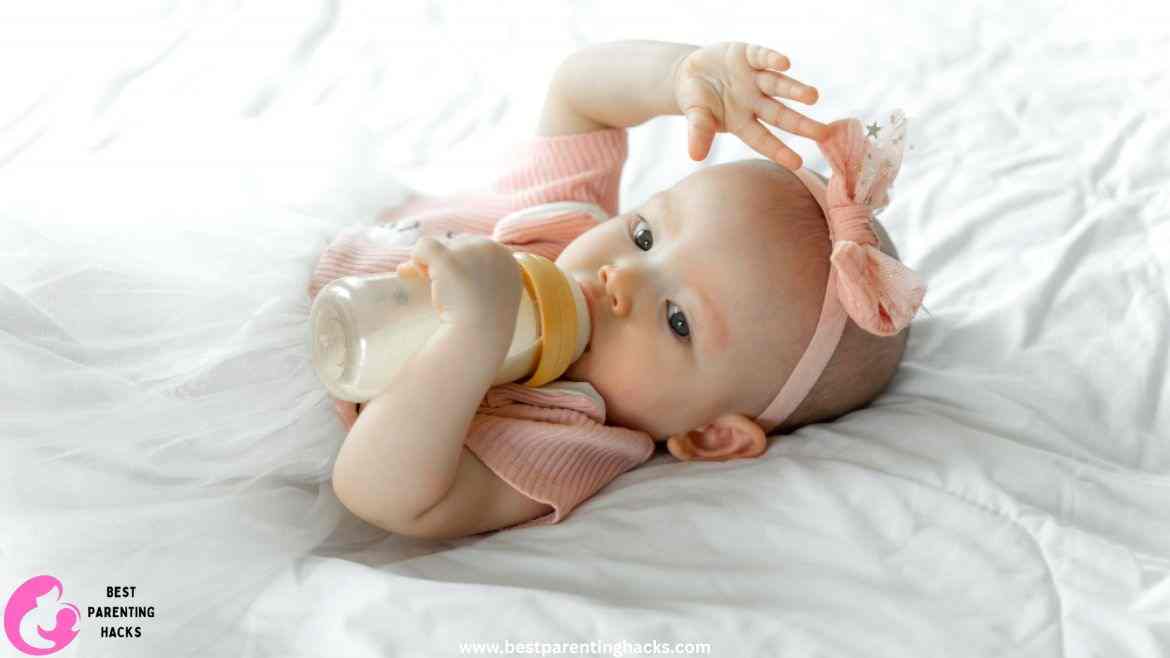Table of Contents
Ensuring the well-being and safety of your child is a responsibility, for any parent particularly when it comes to their nutrition. To protect your kid’s health, sterilizing baby bottles is an essential step in this procedure. It gets rid of dangerous bacteria and germs. However, the work is not finished with sterilization. The next important step is to store these sterilized bottles correctly so that they stay clean until you need them again. Finding the ideal storage option is, in my opinion, just as crucial as the sterilizing procedure itself.
It may not be as simple as it sounds to respond to the query “Where to Store Baby Bottles After Sterilizing?” It entails considering several variables, including accessibility, temperature, and cleanliness. As a parent, I’ve discovered that the best storage method keeps the bottles sanitary, accessible when required, and kept in a way that minimizes the risk of contamination. In this post, I aim to guide you through a range of storage methods drawing from my experiences and thorough research.
Understanding Sterilization
Sterilization is a defense against the unseen dangers that might endanger your child, not merely a normal procedure. Sterilizing baby bottles is more than simply washing them; it’s also about establishing a secure atmosphere in which your child may get nourishment. When I first became a parent, I understood right away how important this process was. It’s not only about how hygienic the bottles are; it’s also about the tranquility they provide.
1. Choose the Right Method: Sterilizing bottles can be done in several ways, such as boiling, using a steam sterilizer, or using a microwave. There are pros and cons to every approach and the optimal choice, for you will depend on your needs and circumstances.
2. Consistency is Key: Sterilization must be done regularly. It’s a regular element of your routine rather than an isolated chore. It is important to make sure that every bottle is sterilized before use.
3. Understand the Importance: The goal of sterilization is to shield your child from pathogenic microorganisms. Taking this measure ensures that your child remains healthy and experiences happiness.
4. Stay Informed and Updated: As with anything baby care related, it’s important to keep up to date on the latest developments in bottle sterilizing techniques. Keeping up with the latest developments in procedures and goods can enhance the efficacy and efficiency of the process.
You Might Also Like to Read: Why My Baby Covers Face with Hands When Sleeping?

Choosing the Right Storage Space for Baby Bottles
When deciding where to store sterilized bottles it is crucial to make an informed decision. It’s all about providing a secure environment for the things that directly affect your baby’s diet. Here are five things to think about:
1. Cleanliness: The storage space needs to be spotless. The sterility of the bottles might be jeopardized by any hint of dirt or bacteria.
2. Temperature and Humidity Control: The best conditions are dry and cold. Even on sterilized bottles, excessive heat or moisture might encourage the growth of germs.
3. Accessibility: It should be simple to get to the storage area. Having to deal with a nuisance each time you need a bottle is something you want to avoid, especially when it comes to those late-night feedings.
4. Separation from Contaminants: Make sure the storage space is kept away from any possible pollutants, such as cleaning supplies or perishable food.
5. Organization: Keeping your storage area neat and orderly not only makes your life simpler but also lowers the possibility that you may unintentionally use an unsterilized container.
You Might Also Like to Read: I Accidentally Gave Baby Tap Water. What Should I Do Now?

Storing Bottles in the Refrigerator
One especially useful way I’ve found is storing sterilized bottles in the refrigerator; the cold climate helps maintain sterility and slows down any possible bacterial development. But there are a few things to keep in mind when storing sterile bottles in the refrigerator:
1. Use a Dedicated Container: To prevent cross-contamination with food items, store the bottles in a clean, dedicated container.
2. Avoid Strong Odors: The bottles may absorb some of the aromas from the refrigerator. This may be avoided by keeping them in a sealed container.
3. Temperature Consistency: Keep an eye on the temperature in your refrigerator because little variations might compromise the sterility of your bottles.
4. Accessibility: Position the container in a section of the refrigerator that is simple to reach, ideally at a manageable height.
5. Regular Cleaning: To keep the area hygienic, clean the refrigerator and the container regularly.
Using Sterilizer as Storage
It is possible to use the sterilizer as a practical and efficient storage container. Here are four easy steps to follow:
1. Ensure the Sterilizer is Clean: Make sure the sterilizer is clean and clear of any water or residue before storing it.
2. Properly Arrange the Bottles: To guarantee that the bottles stay sterile and are accessible, arrange them in an orderly fashion.
3. Close the Lid Securely: To avoid any external contamination, ensure sure the sterilizer lid is always closed firmly.
4. Regular Check and Maintenance: Follow the manufacturer’s maintenance guidelines and keep an eye out for any wear or filth on the sterilizer.

Cabinet Storage Solutions
If done properly, storing bottles in a cabinet may be a terrific solution. This is how I handle it:
1. Choose a Dedicated Cabinet: To prevent cross-contamination, use a cabinet that is only used to store baby bottles.
2. Clean Regularly: Use safe, kid-friendly cleaning products to clean the cabinet regularly.
3. Organize Wisely: To keep the bottles upright and organized, use racks or organizers within the cabinet.
4. Check for Dryness: Make sure there is no moisture accumulation and the cabinet is dry.
5. Accessibility: For convenience, the cabinet should be readily accessible, just like the refrigerator.
Additional Tips for Safe Storage
In my experience, the following extra advice can help ensure that infant bottles are stored safely:
1. Handle with Clean Hands: Before handling sterile bottles, always wash your hands.
2. Regular Inspection: Check bottles often for deterioration or fractures.
3. Avoid Overcrowding: Don’t cram the storage area too full. Contamination by accident may result from this.
4. Label and Date: If you have several bottles in use at once, it might be useful to label the bottles with the sterilization date.
5. Stay Informed: Stay current on the most recent guidelines and best practices for the preservation of bottles.

Conclusion
In a nutshell, sterilizing baby bottles is a task that requires dedication and careful consideration. Ensuring that the bottles remain clean and safe for your baby’s use goes beyond figuring out where to store them. Based on my experience I have come to realize that each storage option has its set of pros and cons. The best choice can differ depending on preferences and specific situations. Recall that the objective is to keep the bottles sterile until further use, protecting your priceless child’s health and well-being.
FAQs
1. How long are sterilized bottles safe to be kept in storage? In a dry, clean atmosphere, sterilized bottles can be stored securely for up to 24 hours.
2. Do bottles need to be dried before being stored after being sterilized? Yes, to stop bacterial development, it is crucial to make sure that bottles are fully dry.
3. Is it okay to keep additional infant feeding supplies next to the bottles? Yes, provided that the storage room is tidy and well-organized and that they are properly sterilized.
4. What should I do if I smell anything emanating from the bottles that are being stored? It is preferable to rewash and disinfect the bottles before using them if there is an odd fragrance.
5. How frequently should I clean the infant bottle storage area? Maintaining a sanitary workplace requires routine cleaning, at least once a week.
6. Can bottles be left in the sterilizer for a whole night? Yes, sterilizers may be a safe storage solution if they are kept clean and closed correctly.
7. Are sterilized bottles safe to keep in a plastic container? Yes, provided that the container is made of food-grade, BPA-free plastic, dry and clean.
You can make sure that your baby’s bottles are stored securely and stay sanitary until they are needed again according to these rules and recommendations. Keep in mind that your baby’s health and safety come first, and following these extra precautions while storing can make a big impact.




